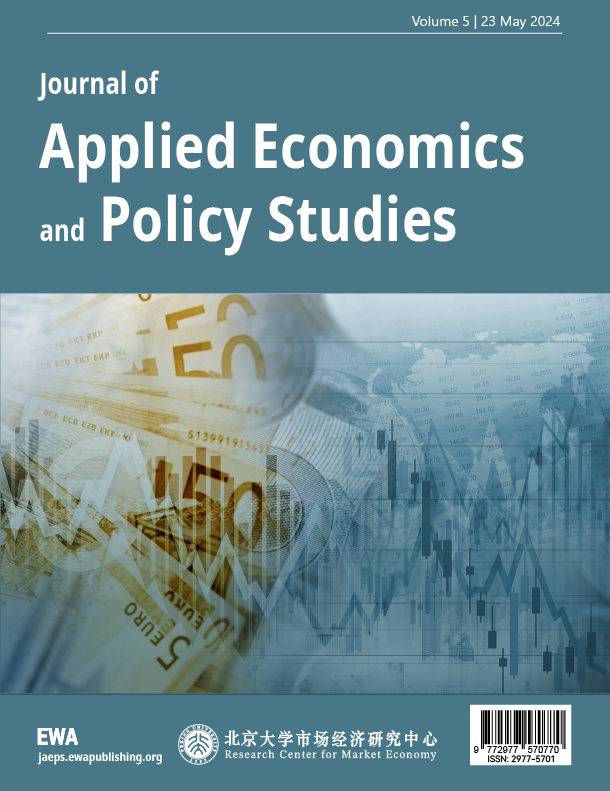References
[1]. Acemoglu, D., & Restrepo, P. (2018). The race between man and machine: Implications of technology for growth, factor shares, and employment.American Economic Review, 108(6), 1488–1542.
[2]. Aghion, P., Bergeaud, A., Lequien, M., et al. (2022). The heterogeneous impact of market size on innovation: Evidence from French firm-level exports.Review of Economics and Statistics, 1–56.
[3]. Guo, K. M. (2019). Artificial intelligence development, industrial structure transformation and upgrading, and changes in labor income share.Management World, 35(7), 60–77+202–203.
[4]. Cai, Y. Z., & Zhang, J. N. (2015). The substitution effect and penetration effect of information and communication technology on China's economic growth.Economic Research Journal, 50(12), 100–114.
[5]. Muscio, A., Nardone, G., & Stasi, A. (2017). How does the search for knowledge drive firms' eco-innovation? Evidence from the wine industry.Industry and Innovation, 24(3), 298–320.
[6]. Magazzino, C., Mele, M., Morelli, G., et al. (2021). The nexus between information technology and environmental pollution: Application of a new machine learning algorithm to OECD countries.Utilities Policy, 72, 101256.
[7]. Wang, X., Feng, Y., Qian, L., et al. (2025). Talent introduction policies, optimal labor allocation, and corporate green innovation.Sustainability, 17(3), 1112.
[8]. Xuan, Y., & Zhang, W. L. (2021). The micro-level impact mechanism of intelligence on enterprise production performance: Taking capacity utilization and profitability as examples.Science of Science and Management of S.& T., 42(11), 96–119.
[9]. Munawar, S., Yousaf, D. H., Ahmed, M., et al. (2022). Effects of green human resource management on green innovation through green human capital, environmental knowledge, and managerial environmental concern.Journal of Hospitality and Tourism Management, 52, 141–150.
[10]. Lasswell, H. D., & Kaplan, A. (1970). Power and society. Yale University Press.
[11]. Zhang, J. M. (1992). Introduction to policy science. China Renmin University Press.
[12]. Chen, Z. M. (2003). Public policy analysis. China Renmin University Press.
[13]. Dunn, W. N. (1981). Public policy analysis: An introduction. Prentice-Hall.
[14]. Dunn, W. N. (2011). Public policy analysis: An introduction (4th ed.). (X. Ming, F. Yan, & Z. X. N., Trans.). China Renmin University Press. (Original work published 1981)
[15]. van Noordt, C., & Misuraca, G. (2019). New wine in old bottles: Chatbots in government. InProceedings of the 11th International Conference on Electronic Participation(pp. 49–59). Springer.
[16]. van Noordt, C., & Misuraca, G. (2022a). Exploratory insights on artificial intelligence for government in Europe.Social Science Computer Review, 40(2), 426–444.
[17]. van Noordt, C., & Misuraca, G. (2022b). Artificial intelligence for the public sector: Results of landscaping the use of AI in government across the European Union.Government Information Quarterly, 39(3), 101714.
[18]. Roberts, H., Cowls, J., Hine, E., et al. (2021). Achieving a 'Good AI Society’: Comparing the aims and progress of the EU and the US.Science and Engineering Ethics,27(6), 68.
[19]. Robinson, S. C. (2020). Trust, transparency, and openness: How inclusion of cultural values shapes Nordic national public policy strategies for artificial intelligence (AI).Technology in Society, 63, 101421.
[20]. Sampath, P. G. (2021). Governing artificial intelligence in an age of inequality.Global Policy,12(S6), 21–31.
[21]. Saveliev, A., & Zhurenkov, D. (2021). Artificial intelligence and social responsibility: The case of the artificial intelligence strategies in the United States, Russia, and China.Kybernetes, 50(3), 656–675.
[22]. Calboli, S., & Engelen, B. (2025). AI-enhanced nudging in public policy: Why to worry and how to respond. Mind & Society [Advance online publication].
[23]. Rooy, V. D. (2025). A cognitive science framework could prevent harmful public policy decisions involving AI.Behavioral Science & Policy, 11(1), 33–43.
[24]. Hakimi, M., Amiri, A. G., & Shamsi, E. S. (2024). Artificial intelligence and public health: Addressing pharmacy practice challenges and policy issues.British Journal of Pharmacy and Pharmaceutical Sciences, 1(1), 9–21.
[25]. Cory, S. R. (2020). Trust, transparency, and openness: How inclusion of cultural values shapes Nordic national public policy strategies for artificial intelligence (AI).Technology in Society,63, 101421.
[26]. Vassilakopoulou, P., Haug, A., Salvesen, L. M., et al. (2023). Developing human/AI interactions for chat-based customer services: Lessons learned from the Norwegian government.European Journal of Information Systems,32(1), 10–22.
[27]. Waldman, A., & Martin, K. (2022). Governing algorithmic decisions: The role of decision importance and governance on perceived legitimacy of algorithmic decisions.Big Data & Society,9(1).
[28]. Levin, L., & Budak, L. (2024). Implementation of public health policies and integration of artificial intelligence and social media in dental traumatology—cornerstones for effective dental trauma management.Dental Traumatology, 40(6), 607–611.
[29]. Li, J., & Yuan, Y. T. (2025). How generative artificial intelligence reshapes public communication: Logical mechanism, potential risks, and response paths.China Publishing Journal,(10), 29–33.
[30]. Wei, Y. M., Jia, K., Zeng, R. X., et al. (2025). Artificial intelligence innovation development and governance transformation under the breakthrough effect of DeepSeek.E-Government,(3), 2–39.



